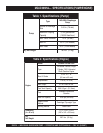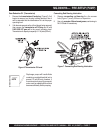
PAGE 12 — MQ-D306HA DIAPHRAGM PUMP — OPERATION AND PARTS MANUAL — REV. #3 (01/09/07)
MQ-D306HA — GENERAL INFORMATION
APPLICATION
The
MQ Model D305HA diaphragm
pump is designed to be
used for de-watering applications. The suction and discharge
ports on this pump
use a 3-inch diameter opening, which allows
the pump to pump at rate of approximately 5,100 gallons/hour
(gph) or 19,305 liters/hour (lph).
Diaphragm pumps use a positive displacement design rather
than centrifugal force to move water through the casing. This
means the pump will deliver a specific amount of flow per stroke,
revolution or cycle. These pumps are commonly referred to as
mud hogs, mud hens and mud suckers. Their names reflect their
popularity for use in applications where shallow depths and slurry
water render centrifugal pumps ineffective
Power Plant
This diaphragm pump is powered by a 5.5 horsepower air cooled,
4-stroke, single cylinder,
HONDA GX-120
gasoline engine that
incorporates a low "
Oil Alert Feature
" . The drive shaft of the
engine is coupled to an offset connecting rod that is coupled to a
flexible diaphragm. The connecting rod alternately raises
(expands) and lowers (contracts) the diaphragm at a rate
between 40 and 65 strokes per minute depending on engine
speed.
Oil Alert Feature
In the event of
low oil
or
no oil
, the HONDA GX-120 engine has
a built-in oil alarm engine shut-down feature. In the event the oil
level is low the engine will automatically shut-down.
Suction Lift
This pump is intended to be used for dewatering applications
and is capable of suction lifts up to 25 feet at sea level. For optimal
suction lift performance keep the suction hose or line as short as
possible. In general always place the pump as close to the water
as possible.
Pump Support
The pump should always be placed on
solid stationary ground
in a level position.
NEVER place the pump on
soft soil
. The suction hose or pipe
connection should always be checked for tightness and leaks. A
small suction leak in the hose or fittings could prevent the pump
from priming.
Elevation
Higher elevations will effect the performance of the pump. Due to
less atmospheric pressure at higher altitudes, pumps DO NOT
have the priming ability that they have at sea level. This is due to
the “thinner air” or lack of oxygen at higher altitudes.
A general rule of thumb is that for every 1,000 feet of elevation
above sea level a pump will lose one foot of priming ability.
For example, in Flagstaff, Arizona where the elevation is
approximately 7,000 feet, the pump would have a suction lift of
only 18 feet rather than the 25 feet at sea level. Table 3 shows
suction lift at various elevations.
Table 4 shows percentage drops in performance as elevation
increases.
suoiraVtassoLecnamrofreP.4elbaT
snoitavelE
edutitlA
sreteM(teeF
wolFegrahcsiDdaeHegrahcsiD
leveLaeS%001%001
)016(000,2%79%59
)912,1(000,4%59%19
)928,1(000,6%3
9%78
)834,2(000,8%19%38
)840,3(000,01%88%87
snoitavelEsuoiraVtatfiLnoitcuS.3elbaT
edutitlA
)sreteM(teeF
)sreteM(teeFnitfiLnoitcuS
leveLaeS)840.3(0.01)275.4(0.51)690.6(0.02)026.7(0.52
)016(000
,2)086.2(08.8)320.4(2.31)463.5(6.71)507.6(0.22
)912,1(000,4)773.2(08.7)665.3(7.11)457.4(6.51)349.5(5.91
)928,1(
000,6)301.2(09.6)961.3(4.01)602.4(8.31)372.5(3.71
)834,2(000,8)988.1(02.6)438.2(03.9)977.3(4.21)427.4(5.51
)840
,3(000,01)737.1(07.5)126.2(06.8)474.3(4.11)853.4(3.41
NOTE
Please contact your nearest authorized MQ
dealer for any accessories that your pump
may require.


















